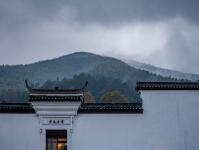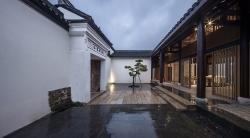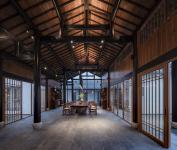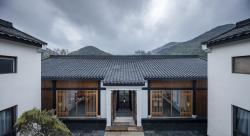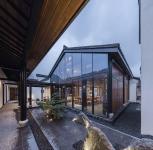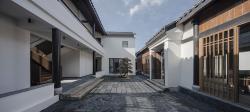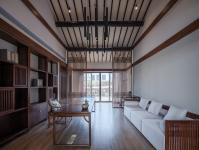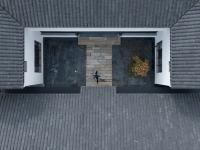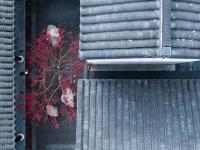he return to pastoral life has long been an ideal of Chinese literary tradition, it is the most romantic way of living deeply rooted in each Chinese’s heart. With the rapid globalization and urbanization, the desire turned into “xiangchou”— a term that refers to nostalgia for rural lands and the hometown that cannot be return for those earned their livings in big cities. Compared to city life Especially when growing older, country life restores the purest parts of life. For the urbanite, country life must be the ultimate escape from the hustle and bustle of city life, just like the famous saying goes:” White flowers are better than green leaves, while strong drinks are not as good as mild tea.”
Background : the original site
Named the Ancestor House, the property was the family mansion first built in 1898 by Zhou Ansheng, the grandfather of the client who tasked Yushe Design for the project. However, the house has been largely derelict for decades since all the family members left hometown for better living. One of his offspring’s nostalgia for the countryside and childhood couldn’t bear to leave it abandoned, so he tasked Yushe Design to restore and renovate it into a boutique hotel with a suite for the family.
When we first visit the site, the house was surrounded by weeds and shrubs, and blossomed red plum. Ancient villages in Zhejiang Province are always in some sort of inherent harmony with nature. The original building was a traditional Chinese courtyard dwelling — three-hall structure with two wings and four internal courtyards, with the main structure of through type timber frame. Except for the characteristic Huizhou-style facade and roof which are well preserved, most of the other original features — the loam walls, wooden roof trusses, timber beams and columns, grey tiles are severely damaged. Under such condition, the building might seem to be of little value to some villagers, but for Zhou’s family, it is a century-old dream and memory. And for us, it was just like an uncut jade to be carved into great works.
We think the best solution to rural revitalization would never be building new houses over old ones, not to mention undisciplined occupation of land. The most appropriate yet difficult way of Chinese rural construction is one that makes people feel at ease in the space without deliberate interference nor imitation of the ancient, as described by a famous saying in Tao Te Ching by Lao Tzu: “ A great sound is inaudible, and a great image is formless.
2017
2019
As a result, the original structure of Huizhou-style façade and walls were revamped and reinforced by steel-concrete structure so as to eliminate air/wind leakage and potential structural risks. The severely damaged through type timber frame were rebuilt according the original structure. Some undamaged beams and stone plinths under the wooden pillars were kept intact, the demolished ones such as grey tiles are recycled for pavements and decoration, echoing the history to the house and the local culture on the tectonic side as well as showing sustainable ecological construction philosophy.
Design Phase: a century response
Famous Chinese writer Lin Yutang, also best known is the West for his English writing once described his ideal home:“Garden within a house, house within a garden, courtyard among rooms, trees among courtyard, sky above trees, moon in sky”, reflecting the most distinctive feature of Chinese home design of all ages is the stone-paved courtyard, just similar in effect to a Spanish cloister, and symbolizing peace, quiet and repose. Courtyards are spiritual place for Chinese ancient literati, and still a longing place for urbanite where they can be assured of being personally pampered in beautiful rural surroundings to get away from the hustle and bustle.
We made it a priority to restore and repair the existing building, keep the original spatial layout, revive the sense of sophistication and stateliness that existed when the original property was first built, an ode to its past. The back hall connects the two floors and with an exquisite wooden stair and provides access and privacy for all the 14 rooms. The disadvantage of traditional courtyard dwelling layout is insufficient of light, thus a side wall of the lobby had to be replaced by glass screen walls to bring in light. The transparence also enhanced the connectivity between the indoor spaces and the open courtyard. No wonder a beautiful poem like “ The white snow/ vexed by the late coming of spring’s colors/ Off set purpose darts among the courtyard’s trees to fashion flying petals”, would be written in such artistic courtyard.
Stepping into the lobby through the low robust rubble wall and a stone-paved courtyard embellished with two local red plum trees, the exploration now starts. In Chinese paintings, blank-leaving is highly valued, we call it “half-half” way. The two courtyards divide the spatial patters and create various circulation route, providing a playful walking experience as well as impressive views.
The family-style setup is perfect for those who want quietude, away from the bustling city. The interiors consist of two ideas, simplicity and space. We brought in few pieces of furniture with simple lines, good quality and extremely polished, which perfectly fuse different hues and texture. Wooden grills and local limestone floor emerged together to create a sense of warmth, naturalness. The new reflects the past without imitating it.
Architecture of time
Architecture is a spatial art, as people always say. But architecture is also a temporal art. ——Peter Zumthor
From design to construction, the restoration of Ancestor House just went through a cycle of four seasons; from ruins to prosperity, the Zhou family’s dream of reviving the old house continued for a century. Rather than an architectural and interior design, it is a shaping of the humanistic pattern of “etiquette”, and a modern rebirth of Chinese residence.
There were always gaps between the ideal of design and the reality of the craftsmen’s experience and techniques, for example, at first, we would like to do antique finish of the facade wall to show the history of the house, but with several rounds of negotiation and mutual compromises, it turns out to be fresh white. The “architecture without architects” in rural areas has revealed a specific situation where it was very hard for architects with trained ways of thinking to truly “root” himself in the village, for his trained experience was not necessarily what was needed there. Anyway, for our design team, this project was a most thorough practice of our “buildingless” approach. The completion of the project hasn’t left a sign of new building on the village, but the landscape at the village entrance, the alleys around the house, and the interior and exterior spaces of the building, were all more harmonious with the people’s life and the village, and more friendly to visitors from outside. This project has also inspired some local villagers thinking of renovation of their own house. in-depth thinking in us.
In the context of China's “beautiful villages” and “village rejuvenation”, Changxing, as one of the main positions for the revitalization of the rural areas in Zhejiang Province, has been formulated in various aspects such as strengthening capital investment, housing system reform, and rural human settlements. With nearly 40 supporting policies and measures, we have reason to expect this new model to attract interesting people to gather, nourish the rural ecology and develop healthily. We believe, lots of characterful country house hotels would follow.
Project Location: Zhouwujie Village, Changxing County, Huzhou City, Zhejiang Province
Floor Area:1202㎡
Architecture & Interiors & Landscape Design: Yushe Design
Principal Architect:Chen Xiao、Li Zhiqiang、Xu Yi、Gao Shantong
Architectural Design:Li Na、Pang Di、Liang Xiuzhu
Interior Design:Mao Lili、Chen Peng、Zhao Xikang
Landscape Design:Yu Haoyan、Chen Jingfeng、Ma Jiang
Timber Frame Design and Construction: JAZBUILD
Design Phase:2017.3-2018.7
Construction:2017.11-2019.11
Photography:Fancy Images


